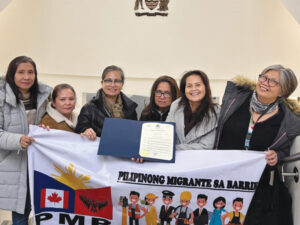Welcome to this column’s first entry. Daloy-Puso means flowing from the heart. A group of young scholars and leaders organized Daloy-Puso events series which opened in 2015.
Our Filipino-Canadian youth identified the need for them and their elders to speak from their hearts, not just from their mouths and heads. The series led to an informal network of community members who continue to work with and for youth, which include individual members from Tulayan, Kababayan Academic Mentoring Program (KAMP), Fil-Net, Pinoy Pride, One-Fil Co-op, Parents Support Group, Sulong UBC, GABRIELA, Migrante BC, National Pilipino Canadian Cultural Center (NPC3), among others.
Like my column RESPECT in the online Canadian Filipino News, I aim to contribute to the collective empowerment and transformative change of Filipinos in Canada. My guests and I believe that we can be responsive and accountable in our engagement and service in the community, as we imagine new possibilities for education, leadership and capacity-building.
We can nurture transformative change within Filipino communities in Canada through the cultivation of critical thinking, critical media literacy, and life-long learning skills.
We need critical thinking among citizens and learners, now more than ever, in an age of information technology, social media, knowledge economy, and unimaginable crises and catastrophes such as climate change and COVID19.
As Filipinos in Canada, we need to engage in civic discourse and informed conversations in mainstream Canadian society, and the world, using our stories, our voices and perspective about the economy, politics, health, education, culture and overall life and well-being in our adopted country.
Please email me your ideas on this agenda: [email protected]
Filipinos and Anti-Black Racism
As Filipinos commemorate June as Philippine Heritage Month in Canada, we can think of parallel experiences in the historic relations between Filipinos and African-Americans. We need this historical knowledge to provide support to Black Lives Matter and other anti-racism movements, including racism against Asians during the COVID-19 pandemic.
Online searches for Filipinos and African-Americans lead us to websites on famous mixed-race Black Filipino-Americans in music, basketball and other sports. There is more to our shared history.
There are more commonalities in our experiences, including race profiling in policing practices. The “modern day lynching” of George Floyd in Minneapolis, Trayvon Martin in Florida, and Ahmaud Arbery in Georgia, reminded us of police brutality that led to the death of Jeffrey Reodica in Toronto.
Common experiences of racism, European-American empires and colonialism compel us to think of how Filipinos “became Blacks” historically.
Post-colonial Filipinos have learned to distance themselves from Black people. With the triumph of American Empire in the Philippines and the spread of American popular culture, rich Filipino oligarchs and elites, who often pride themselves as being Hispanic or Chinese mestizos, alongside ordinary Filipinos, have imbibed the racist beliefs and practices of our colonizers.
Distancing ourselves from Black people and Black culture happened gradually as Philippine national identity and consciousness became linked with class, gender, language and other identities.
This distancing occurred simultaneously with our own disparagement and devaluation of Indigenous Peoples in the Philippines, and denial of our own roots as Indigenous Tagalogs, Waray, Iloko, Ilonggo, Pampangans, etc.
While Filipinos in the Philippines and the diaspora consume Black music, sports and products, we are among the world’s biggest consumers of skin whitening products, especially upper and middle class women. Try finding any personal hygiene products without skin bleaching ingredients in Manila supermarket aisles.
We do not want to dark skin. We associate beauty with fairness.
While we do not have as refined a practice as Brazilians who allegedly have at least 50 different words for various skin tones, we use Morena, Mestiza, or Chinita for skin tone and looks. “Mas maputi ako sa iyo,” (I am fairer than you) is an assessment phrase of where we slot ourselves and others in the skin-tone hierarchy.
We reserve distinct words for blackness as insults – itim (black), sunòg (burnt), uling (charcoal/soot), tutong (burnt rice) negro, negrito/a, kulot (curly hair), Aeta, Nog-Nog (to a Black cartoon character in the 1980s), Whitney Tyson (a Black Filipina actor popular in the 1990s).
We do not want anything Black, which colonial thinking taught us to associate with dirtiness, ugliness, criminality, darkness, backwardness, sin and hatred.
People invent, shape and reshape race and ethnicity, and the words we use for these. As academic researchers say, race is not biological but a social construction.
Historically, due to racism, violence, and racial injustice in colonial wars, Filipinos became “a race” within Asia. Although Filipinos are also Asians, and the Philippines is also located in Asia, internal racism arose in the region. Largely due to our slower economic growth and the over-representation of Filipinos in domestic work and domestic-like service occupations in the new industrialized countries of Singapore, China, South Korea and Taiwan, we hear people say, “Filipinos are the Blacks of Asia” or “Filipinos are the Mexicans of Asia.”
These racialized references are historically traceable to the Filipino-American War of 1899-1913. This war, etched in our collective memory through the Sunugin ang Samar movie, recently emerged in public discussion with the return to the Philippines of the Balanginga church bells, which American soldiers took as war booty. This “bloodiest colonial war… ever fought by a white power in Asia” was “among the cruelest conflicts in the annals of Western imperialism”.
Racism, or what W.E.B. Du Bois called “the problem of the color-line,” killed almost twenty percent of the entire Philippine population. It was the overseas extension of white settlers’ conquest of Native Americans lands and Blacks African bodies brought as slaves from Africa.
Filipinos were dark-skinned Orientals “killed in an orgy of racist slaughter.” Conquest and occupation occurred in the name of civilizing this “barbarous race,” “new-caught sullen peoples, half-devil and half-child.”
White American soldiers and officers thought of Filipinos “just the same as the American Negro,” if not the Native American Indians, and called them “indios”, “indians”, “niggers”, “negros” and “blacks. White soldiers often mistook their Black counterparts as Filipinos, according to Black soldiers writing home.
As unwilling witnesses of white racism and cruelty towards Filipino insurgents and civilians – from “water cure”, “butchering”, “hamletting,” rape, and other counter-insurgency tactics Americans would later use in Vietnam — Black American soldiers were reminded of lynching and other sufferings Black people endured back home.
Questioning their presence in the archipelago and the true intents of the war, many African-American soldiers deserted, cut short their service, or joined Filipinos fighting for independence. Many stayed behind and never returned to the US. More than 1,000 African-American soldiers married native women, practiced their professions and established businesses in the Philippines throughout American occupation.
David Fagen, perhaps the most famous Black soldier in the Philippines during this time, trained guerillas under General Jose Alejandrino, and became the subject of numerous books and articles.
Some African-Americans might be ancestors in our Filipino family trees. Some might even say, since Homo Sapiens came out of Africa according to historical anthropologists, we all have African roots. There is only race, one human race, after all.
Thinking about these shared histories and genealogies between Filipinos and Black Africans is a good way of commemorating Philippine Heritage Month when we all need to rally against racism, particularly anti-Black racism.
***
By Leonora C. Angeles








